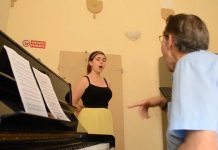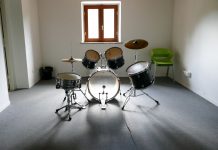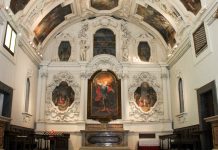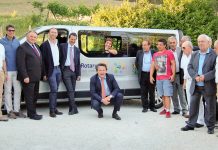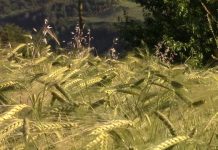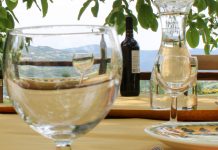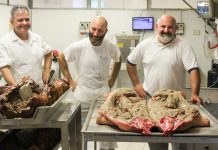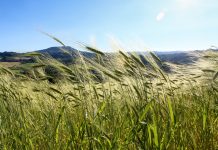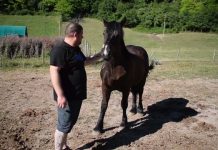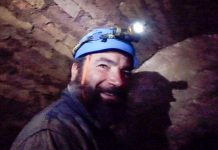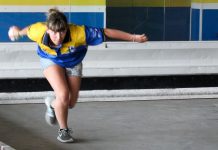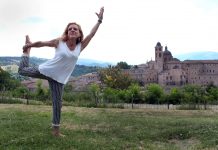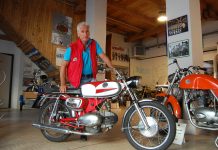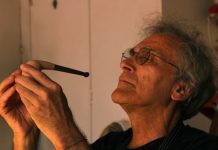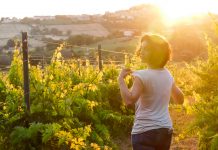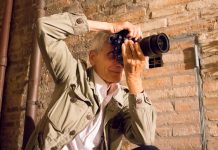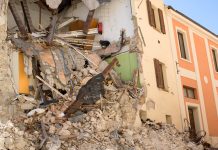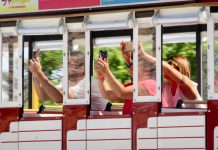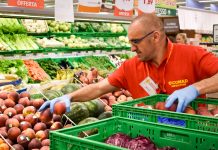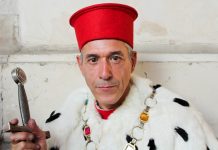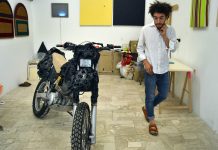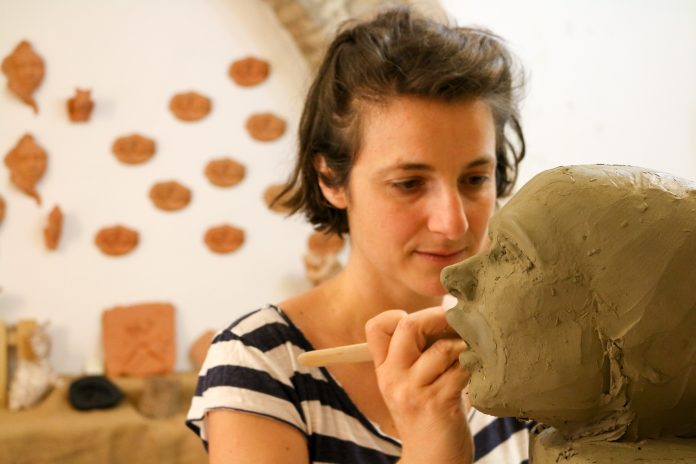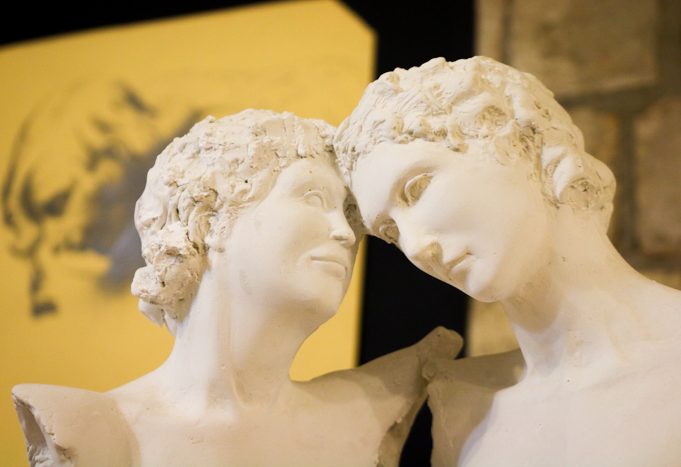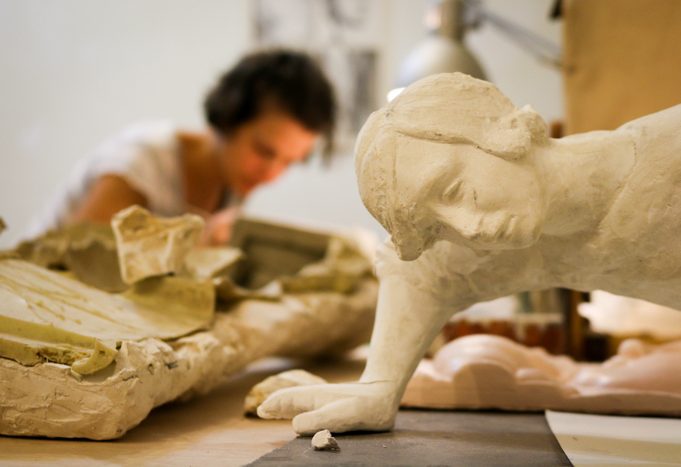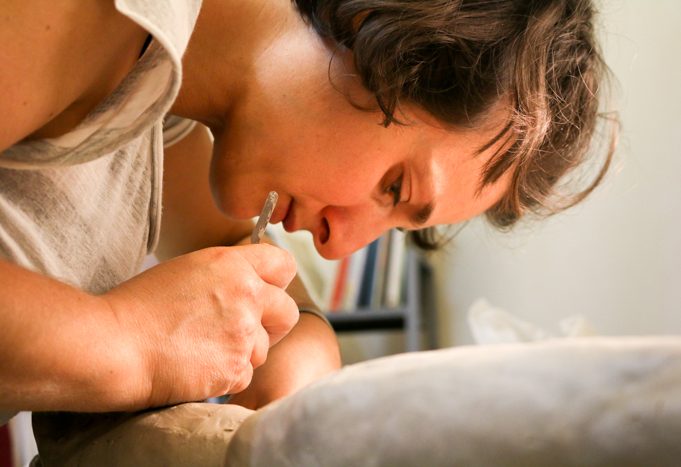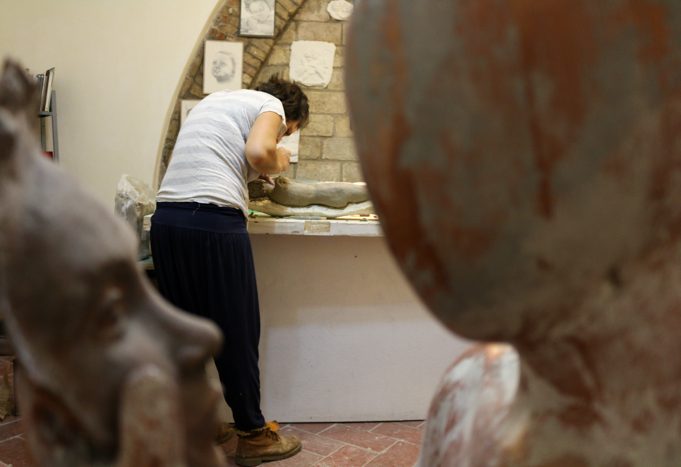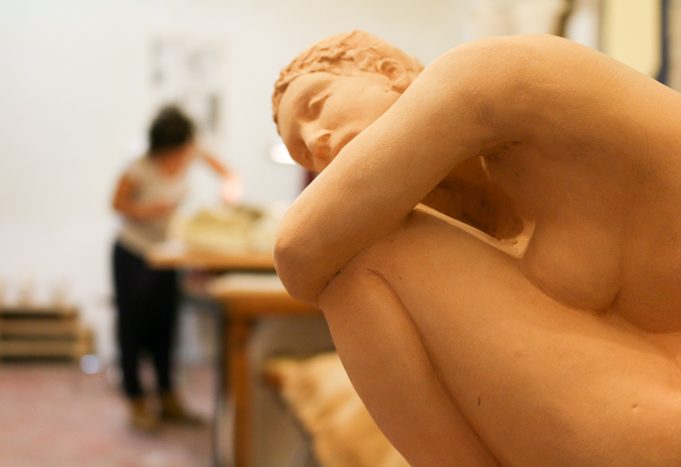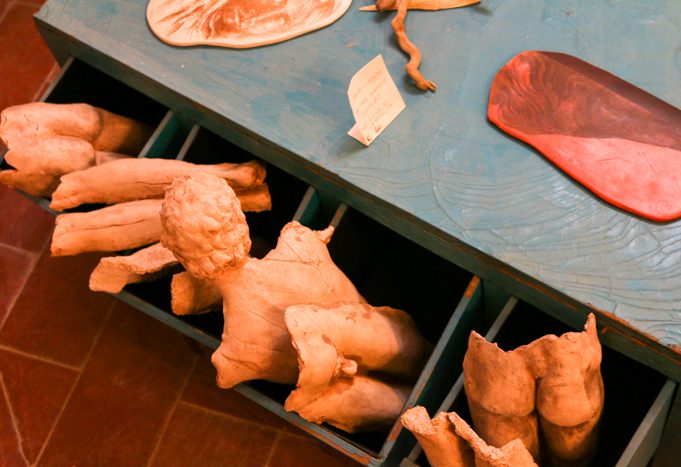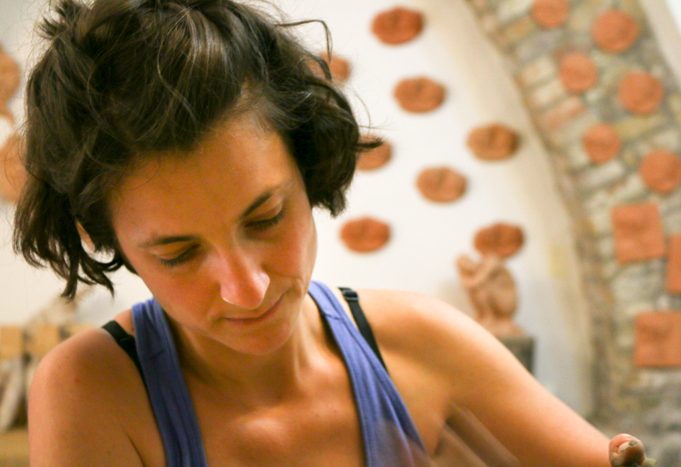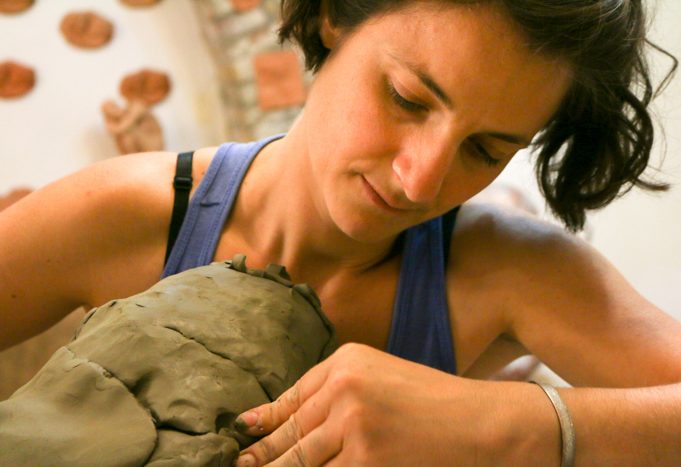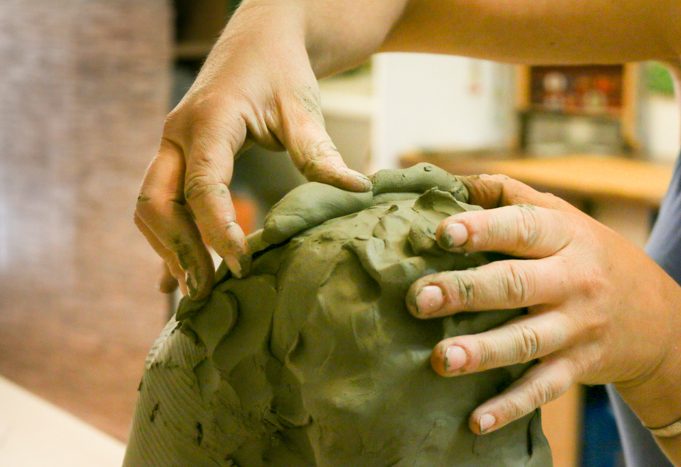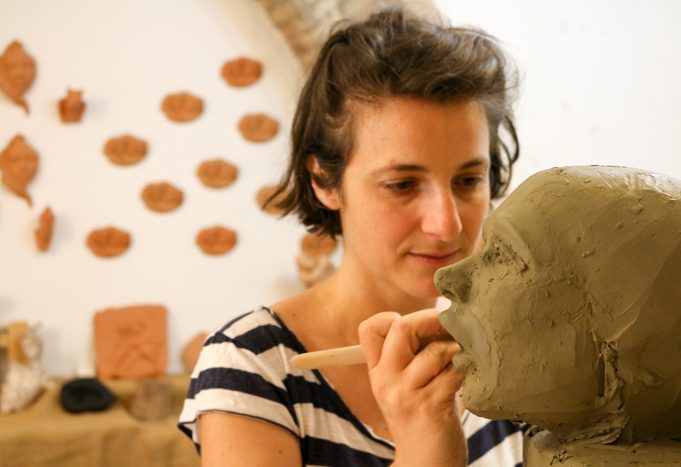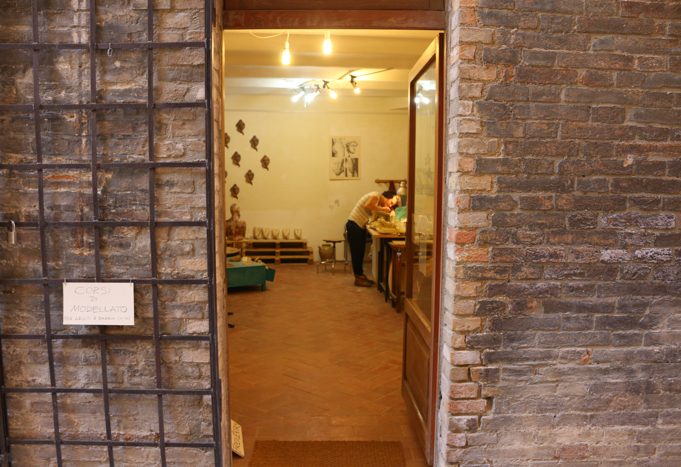An Urbino-based sculptor shows that to move forward, sometimes it is best to look to the past
It is morning, and Giovanna Giusto has just opened her studio for the day. The shop is free of customers for the moment. The quiet is disturbed only by pop music’s latest hits, which drone from an old boombox that sits on the ground next to a table, upon which Giusto is hard at work on her latest piece.
Her hands are wrapped in a thin layer of clay, which seems to never fully wash away.
She has carefully peeled back the casting from her sculpture, but the piece is still far from finished. She rolls a piece of clay between her hands to warm it up and starts applying it, repairing imperfections left by the mold. A few feet away stands the same sculpture, already completed: two male figures, standing about two feet tall, their heads bowed together. The bodies are without arms, so this is the closest they can get to an embrace. It is a preview of what this piece will look like once Giusto has finished with it.
Giusto is relatively new to Via Valerio, Urbino’s “Street of the Arts.” She opened shop here in December of 2016. All the same, the walls of her studio are lined with evidence of her labor; dozens of small, identical faces are spread over the drywall like clouds in a sky. On another wall are charcoal sketches of Michelangelo’s David, a source of inspiration.
In an art scene dominated by innovation and forward thinking, Giusto’s sculptures dare to do exactly the opposite; they throw their viewer into the past.
Glancing around Giusto’s studio is like stepping into the Italian Renaissance. There is not a single piece of abstract or modern art to be found. Piero della Francesca’s portraits of the Duke and Duchess of Urbino are re-created in miniature, their features carved out of clay rather than painted by brushstroke. A sketch of an angel hangs alongside its sculpted counterpart. Spread throughout the studio are small human figures, their limbs curled around themselves, a reflection of their creator’s introverted disposition. Next to one of the wall displays is a table with drawers full of various body parts and limbs, fragmented in ways that should seem macabre, but are instead beautiful in their detail.
“When I first began studying art, I looked at the classics and loved them. Other types, I don’t understand them,” Giusto says.

Giusto hopes that, through her own art, she might spark some nostalgia or emotion within her viewers, just as the works of sculptors like Michelangelo, Canova, and Bernini have done for her.
“Modern art does not compute with me,” she says.
Upon beginning her studies at the Accademia di Belle Arti di Urbino, however, she was disappointed to find that she seemed to be the only artist with a passion for the classics. Her fellow artists—including her professors—were uninterested in humanism.
It was after her first unsatisfying stint in art school that Giusto signed up for another sculpting course in Sant’Ippolito, where she met the professor and artist who would become her mentor, Ermes Ottaviani. He was inspiring, and after meeting him again at another course a few years later, Giusto took it as a sign to pursue her art as a career.
In an art scene dominated by innovation and forward thinking, Giusto’s sculptures dare to do exactly the opposite; they throw their viewer into the past.
Even after fifteen years, the pair maintain a working relationship, collaborating often in their sculpting projects. As far as artistic style, the two are very similar, both appreciative of the classics and the human form.
Now, as Giusto begins to distinguish herself as a sculptor in Urbino’s center, Ottaviani has retired from teaching and lives and works in his home just outside of town. His house doubles as a studio for his work and overlooks the countryside, the Adriatic Sea, and—in the winter months when the trees are thinner—the towers of Urbino’s Palazzo Ducale.
Ottaviani was a professor in northern Italy before moving back to his birthplace of Urbino to teach for another thirty years. He has taught hundreds of students, which makes Ottaviani and Giusto’s enduring relationship seem that much more exceptional. Ottaviani talks about his student with an amount of admiration and respect which speaks to Giusto’s ability as an artist.
“[Giusto] has always preferred what I recognize—the classics. The great artists like Canova and Michelangelo,” Ottaviani says. He sits in his yard surrounded by what must be years-worth—if not decades-worth—of his own work. The sculptures and paintings cover every square inch of available space in the garage and ground-level studio, and spill over into the yard. They are an amalgamation of materials, wood with metal with clay, and a fusion of past and present, religious and secular. A commission leans next to a wall on one side of him, a winter scene with angels painted in various shades of blue and white. On his other side is the figure of a woman, emerging from a slab of wood as if apparitional.
“The diversity of each artist depends on their passion and confidence,” Ottaviani says of Giusto. “If you believe in what you do and do it with passion, it will transfer on to your work. She is an artist who has a lot of passion in what she does. She believes.”
* * * * *
Giusto was born in Lecco, a city in northern Italy about 30 miles north of Milan. Her love for classical art—and dislike of big cities—is what brought her to Urbino for her studies.
“Lecco is at least ten times bigger than Urbino,” she says.
Here, in this tiny Renaissance town in the Marche, Giusto fell in love with the landscape, the architecture, and the slow pace of daily life. Urbino is the type of small town where everyone knows everyone. Giusto smiles and greets every passerby on Via Valerio, often by name, through a shop door that is always open.
“I like the countryside. When you live in the city…it’s too much. Too many houses, too many streets. They are too congested. Here, you can see the stars. In the city, you turn and there is a ten-story building in your face,” Giusto says as she carves an ear into the side of the piece she is currently working on.

Just a few days ago, it was a misshapen block of greenish clay. Now it has been transformed into a woman’s head, gaze forward, mouth slightly agape as if staring at something in awe. It is a larger version of a piece that already hangs on her wall.
Giusto says she prefers to sculpt bigger pieces, but she is no stranger to downsizing.
She laughs as she recalls the years before she moved into her studio, when she was working from her home. Not only is sculpting an exceptionally dirty job, but it also requires a workspace. Pressed under the weight of a small house, two children, and a collection of instruments—courtesy of her musician husband, Luca—Giusto’s sculptures continued to shrink.
“I had a small table like this,” she says, rotating the table that holds her sculpture, “and would work on a tile or a piece of wood [and move from place to place]. It was stressful. We didn’t have money to rent a house with a garage. This way, you could never develop. You can’t do it in a small house. If you have a workshop in your house, then yes. But it was terrible.”
To make ends meet, Giusto made purses, hats, and jewelery to sell. It was okay. But it was not what she wanted to do.
“Yes, you like your life and love your family, but you feel like something is missing.”
Being able to open her studio on Via Valerio is what saved her. It gave her the space to do the work she loves, to develop the style she is so passionate about, and to be noticed.
Marcello Pucci is a fellow artist on the Street of the Arts and was an early supporter of marking Via Valerio as a sanctuary for art and artists. “There is a lot of art in the city but there are no longer artisans here,” Pucci says, sitting in his own pottery workshop, just down the street from Giusto’s. Between them and directly next to Giusto is Rubén Rojo, a jewelery maker who crafts his pieces using dust and minerals collected from the very walls of his lab. There are still two more vacant studios on the street, lying in wait for new occupants.
“I wanted to re-create workshops so that the people who live here and those who frequent Urbino have the chance to see art being created,” Pucci says. “Urbino had many artists in the past, not just Raffaello. They worked in the city and produced a service. There was an important population of artists from all of Italy who worked here.”
To win a spot on the street, like Giusto did, Pucci says artists must enter a competition, of sorts. The contenders show their artwork, and the winners are decided by the people of Urbino. Whoever draws the most attention and garners the most business is given the opportunity to open a shop on Via Valerio. The people of Urbino, it would seem, found Giusto’s old style of sculpture to be appealing, and the same can be said for the other artists on the street.
Pucci says he draws his own methods from the past, from the Romans, but his style is modern. Rojo, the jewelery maker, harvests the old to create the new. Each of these artists sits upon a wall that divides past and present, and Giusto is no different, realizing old concepts with new methods of creation.
“I look to the past,” she says.
“That is special for me.”
Slideshow
This article also appears in Urbino Now magazine’s Arte e Cultura section. You can read all the magazine articles in print by ordering a copy from MagCloud.


